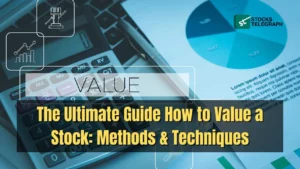One of the most popular investment philosophies remains that of seeking value stocks.
It is what Warren Buffett has committed to since his early days in the financial world, and also what turned him into a kingpin.
Identifying stocks that are trading at prices far below their intrinsic value is a sure way to see one’s capital takeoff.
Unlike growth stocks, investors that target such stocks are always on their toes, calculating the best entry and exit points.
Although this may entail a higher degree of risk, as well as a more active approach to investing, its rewards far outweigh the costs.
Historical trends suggest that since the financial crisis of 2008, these stocks have consistently underperformed growth stocks.
The present macroeconomic circumstances, however, have put these dynamic investments back in the game.
High rates of inflation and even higher rates of interest spell bad news for growth chasers. This brings out a wonderful opportunity for these stocks.
In this article, we bring forward five highly promising value stocks invest in now.
What Are Value Stocks?
Value stocks are shares of companies that are considered to be trading at a price lower than their intrinsic value.
These companies are often characterized by stable earnings, strong cash flows, and solid balance sheets.
The market may have overlooked these stocks or undervalued them due to temporary factors such as industry downturns or negative sentiment.
Value investors believe that these stocks have the potential to rebound and generate significant returns in the long run.
How To Find Value Stocks to Invest In
Finding value stocks with promising growth potential is a key skill for investors seeking long-term returns.
By identifying undervalued companies, investors can capitalize on opportunities that the market may have overlooked.
Here are some effective strategies and considerations to help you discover top value stocks worth investing in.
-
Fundamental Analysis
Conduct thorough fundamental analysis to evaluate a company’s financial health, including its balance sheet, income statement, and cash flow statement.

Look for undervalued stocks with strong fundamentals, such as low price-to-earnings ratio (P/E), healthy cash flow, and solid earnings growth potential.
-
Contrarian Approach
Consider adopting a contrarian approach by seeking out companies that are temporarily out of favor or experiencing short-term challenges.
These situations can present attractive entry points, as market sentiment may overshadow a company’s intrinsic value.
-
Sector Analysis
Analyze different sectors to identify industries that are currently undervalued or poised for future growth.
Look for sectors undergoing positive structural changes or those with promising innovation and technological advancements.
-
Margin of Safety
Look for companies with a significant margin of safety, meaning their stock price is significantly lower than its intrinsic value.
This provides a buffer against potential downside risks and increases the probability of long-term gains.
-
Dividend Yield
Consider investing in stocks with attractive dividend yields.
Dividends not only provide a regular income stream but can also be a sign of financial stability and management’s confidence in the company’s future prospects.
-
Quality Management
Assess the competence and integrity of a company’s management team.
Strong leadership with a proven track record of success is often an indicator of a company’s ability to navigate challenges and create long-term shareholder value.
-
Comparative Analysis
Compare a company’s valuation metrics, such as P/E ratio and price-to-book ratio (P/B), with its industry peers to identify potential undervaluation.
Look for stocks that are trading at a discount compared to their competitors.
-
Long-Term Prospects
Evaluate a company’s long-term growth prospects, taking into account factors like market trends, competitive advantages, innovation, and potential for international expansion.
Look for companies with a sustainable competitive edge in their respective industries.
Best Metrics to Keep an Eye While Investing in Stocks
When investing in stocks, there are several metrics that can provide valuable insights into a company’s financial health and potential. Here are three key metrics to consider:
-
P/E Ratio
The P/E ratio measures the current stock price relative to its earnings per share.
A low P/E ratio compared to the industry average or a company’s historical P/E ratio may indicate an undervalued stock.
However, it’s essential to consider other factors and compare the P/E ratio to industry peers before considering any value stocks invest in now.
-
Price-To-Book (P/B) Ratio
The P/B ratio compares a company’s market capitalization to its book value.
A low P/B ratio suggests that the stock is potentially undervalued, as investors are paying less for the company’s assets.
However, it’s crucial to assess the company’s balance sheet and understand the reasons behind the low ratio.
-
PEG Ratio
The price/earnings to growth (PEG) ratio factors in a company’s earnings growth rate when evaluating its P/E ratio.
A PEG ratio below 1 may indicate that the stock is undervalued relative to its growth prospects.

It considers both value and growth aspects, making it a valuable metric for investors looking for balanced investments.
What Is Value Investing?
Value investing is an investment strategy pioneered by Benjamin Graham and later popularized by Warren Buffett.
It involves identifying undervalued stocks that have the potential for long-term growth.
Value investing involves patience and a long-term perspective. Investors aim to buy stocks when they are undervalued and hold them until the market recognizes their true worth.
The strategy requires thorough research, analysis, and the ability to assess a company’s competitive advantage and potential for future growth.
Value Investors
Value investors employ various strategies to find value stocks.
They often start by screening the market for stocks that meet specific criteria, such as low P/E ratios, low P/B ratios, or high dividend yields.
Additionally, they look for companies with solid fundamentals, sustainable competitive advantages, and strong management teams.
Value investors also pay attention to market trends and sentiment. They analyze industries that may be experiencing temporary setbacks or negative sentiment, leading to undervalued stocks.
By conducting in-depth research and understanding the factors affecting a company’s valuation, value investors can identify potential value stocks invest in now.
How Do You Find Value Stocks?
Finding value stocks involves a combination of analysis and intuition.
First, scrutinize financial statements, looking for companies with low P/E ratios and solid balance sheets.
Also, assess their dividend yield and cash flow stability. Next, evaluate industry trends and competitive advantages to identify undervalued companies with growth potential.
It’s crucial to investigate management’s track record and its alignment with shareholders’ interests. Diversification across sectors is important to mitigate risks.
Additionally, leverage qualitative factors like brand reputation and market sentiment.
Finally, keep vigilant eyes on market volatility, seizing opportunities when temporary setbacks depress stock prices, allowing uncovering of hidden value, and maximizing returns.
30 Value Stocks to Invest In
We’ve compiled a list of our top 5 top value stocks for 2024 We believe these stocks have the potential to generate long-term returns and offer attractive entry points for investors.
We recommend researching the companies thoroughly before investing and allocating funds across different types of investments for diversification.
-
Exelon Corporation
Exelon Corporation (NASDAQ: EXC) takes the lead on our list of promising utilities. What sets EXC apart is its remarkable value proposition, especially considering its current price.
As a regulated electric utility, EXC has solidified its position as a key player in the energy sector over the past decade.
It proudly boasts Fortune 200 status and holds the title of the largest energy delivery company in the US.
EXC is currently serving over 10 million customers through six fully regulated transmission and distribution utilities.
The year 2023 has kicked off on a positive note for EXC, with impressive financial results for the first quarter.
In May, the company announced non-GAAP Adjusted Operating Earnings of $0.70 per share, surpassing the first quarter of 2022 by $0.06.
This success can be attributed to increased revenues resulting from customer-oriented investments.
Furthermore, EXC has made significant progress in its debt financing activities for the year and has filed all but one of its planned rate cases.
Thus, it is well on track to fulfill the objectives set at the beginning of the year.
Notable highlights from the recent quarter include GAAP Net Income of $0.67 per share and Adjusted (non-GAAP) Operating Earnings of $0.70 per share for the first quarter of 2023.
Additionally, EXC has affirmed its guidance for full-year 2023 Adjusted (non-GAAP) Operating Earnings, expecting a range of $2.30 to $2.42 per share.
It has also reiterated its commitment to a fully regulated operating EPS compounded annual growth target of 6-8% through 2026.
EXC’s outstanding metrics position it for further growth and success.
With a low debt-to-equity ratio of only 1.67 and a dividend yield of 3.51%, the company demonstrates financial strength and provides attractive returns to its shareholders.
Exelon is excessively undervalued given its price, which has fallen 10.73% in the last 12 months.
Despite this, it is well-positioned with a 12-month P/E of 18.15%.
The stock is a must-buy with the likelihood of delivering an attractive return to its shareholders with a forward P/E ratio of 16.35%.
-
Hologic Inc.
Next up on our list, we present the healthcare equipment manufacturer and supplier, Hologic Inc., (NASDAQ: HOLX).
Hologic is set to captivate investors with its resilience and growth potential.
The company has thrived in a market driven by the urgent demand for healthcare solutions, especially amid the rampant spread of Covid-19 in the United States.

Impressively, Hologic has consistently exceeded projected quarterly earnings per share since 2020.
With 60% of Covid-related sales concentrated in the US market, HOLX is well positioned to sustain its upward trajectory for years to come.
Notably, the company recently obtained clearance from the U.S. Food and Drug Administration (FDA) for its Panther Fusion SARS-CoV-2/Flu A/B/RSV assay.
This molecular diagnostic test effectively detects and distinguishes four prevalent respiratory viruses, including SARS-CoV-2, flu A, flu B, and RSV.
Hologic has already shipped over 200 million SARS-CoV-2 laboratory diagnostic tests worldwide since the pandemic’s onset.
The FDA’s approval of the Panther Fusion assay follows the previous CE marking in Europe in July 2022, solidifying Hologic’s status as one of the globe’s largest molecular diagnostic companies.
Beyond its impressive market presence, HOLX stands out as a value stock due to its remarkable generation of free cash flow.
This financial prowess has significantly bolstered the company’s fiscal position, resulting in a substantial increase in cash reserves.
HOLX’s reserves increased from $1.17 billion to $2.34 billion in the most recent quarter, year-on-year.
This surplus liquidity empowers Hologic to invest in expansionary initiatives and further research and development endeavors.
Despite these strong fundamentals and exceptional prospects, HOLX remains undervalued, with a mere 12% increase in the past 12 months.
Consequently, it presents an excellent opportunity for investors to acquire valuable stock for their portfolios.
-
ResMed Inc.
Moving on to the third value stock on our list we present ResMed Inc (NYSE: RMD).
RMD stands out as an exceptional choice when it comes to medical devices and cloud-based healthcare software investments.
Its remarkable value adds to its allure, and it has proven to be a long-term cash generator.
RMD thrives in a market that remains resilient even during times of macroeconomic volatility and shocks.
Investors who have held RMD stock for the long haul have witnessed extraordinary capital appreciation, as its price surged from $30 to nearly $210 in just the past decade.
The growth trajectory of this company shows no signs of slowing down.
During the third quarter, RMD experienced a substantial increase in the production and delivery of its cloud-connected flow generator devices, catering to sustained high demand worldwide.
The company now offers its connected AirSense 10 platform globally and continues to expand the production and availability of its AirSense 11 platform across various regions.
This expansion enables RMD to meet the global demand for CPAP and APAP devices, effectively serving the entire sleep device market.
This development is particularly advantageous for physicians, providers, and, most importantly, patients.
RMD also witnessed impressive growth in its mask and patient interface businesses globally, indicating a steadfast commitment to patient adherence and resupply.
Furthermore, RMD’s software-as-a-service business outside of hospitals achieved strong organic growth in the high-single-digit range.
It experienced even greater double-digit growth with the contribution of MEDIFOX DAN, a company it acquired in November.
This performance contributed to RMD’s overall revenue growth of approximately 29%, reaching $1.12 billion.
Such impressive product diversification positions RMD as a robust and highly appealing stock option.
Despite its consistent success and ongoing growth, the stock has only seen a marginal increase of 0.4% over the past 12 months.
Year to date the rise stands at a modest 4% indicating that the stock may be significantly undervalued.
And that highlights a remarkable achievement in a challenging market environment where many companies are struggling.
-
Domo Inc.
Number four on our list is Domo Inc., (NASDAQ: DOMO) a business intelligence cloud-based business.
Despite experiencing significant challenges, particularly in the previous quarter, DOMO has struggled to maintain its value and shows great potential from a long-term perspective.
While the Q1 2024 results only led to a modest 2% increase in DOMO, they managed to keep the market sentiment intact.
However, it is crucial to take a broader view of the situation and recognize the stock’s underlying strengths, which far outweigh the temporary setbacks caused by panic-driven price drops.
In the recent quarter, DOMO witnessed a 7% increase in quarterly revenue, soaring from $74.46 million to $79.46 million on a year-on-year basis.
Additionally, the net loss per share improved from 99 cents to 69 cents.
More importantly, the company’s margins experienced a significant boost, with gross profit rising from $56 million to $61 million year-on-year.
These impressive pro forma gross margins position DOMO for future profitability and scalability.
Furthermore, DOMO’s unique business intelligence capability and relatively small size make it an attractive acquisition target for larger tech companies, as suggested by numerous analysts.
With these factors in mind, it becomes evident that DOMO represents an exceptional value stock in the business intelligence sector.
Its potential for growth and profitability, coupled with the likelihood of an acquisition, solidify its position as a highly valuable investment opportunity.
-
Garrett Motion Inc.
The final stock on our list, and far from being the least is the auto parts and equipment star, Garrett Motion Inc (NASDAQ: GTX).
The specialized company focuses on turbo-charged and electric-boosting technologies.
GTX recently made an exciting announcement regarding its collaboration with BMW Group in the development of zero-emission hydrogen fuel cell vehicles.
GTX is lending support to BMW Group’s endeavor by providing an advanced electric fuel cell compressor (FCC) developed by Garrett’s skilled R&D team.
This partnership will be showcased in the upcoming BMW iX5 Hydrogen, where Garrett’s modular fuel cell compressor will enhance its second-generation hydrogen fuel cell drive train.
GTX has been diligently working alongside BMW Group for the past four years, tailoring an advanced hydrogen fuel cell compressor to meet their specific requirements.
The culmination of this effort will be a comprehensive on-road trial scheduled for later this year.
This collaboration underscores Garrett’s commitment to investing in innovative technologies and leading the way in hydrogen-powered propulsion systems.
In addition to its groundbreaking advancements, GTX recently simplified its capital structure by converting its Series A Preferred Stock into a single class of Common Stock.
This strategic move aims to enhance market capitalization, increase liquidity, facilitate index inclusion, and foster a more diversified shareholder base.
Effective June 12, 2023, trading of the Series A Preferred Stock on Nasdaq was suspended.
Each holder received one share of Garrett’s Common Stock for each previously held share of Series A Preferred Stock.
This conversion eliminates the 11% Series A Preferred Stock dividend, further bolstering Garrett’s cash flow profile.
GTX has positioned itself favorably in the vast market it serves, and despite a 7% decline in its stock price over the past 12 months, its true value is far from reflected in its current trading level.
Furthermore, we have compiled a list of 30 such stocks to look out for in 2024 that offer the maximum value.
Several factors have been considered when selecting these stocks, including their PE ratio, along with their potential to rise in value in the coming years.
We recommend investors research these stocks thoroughly before making any decisions.
| No. | Ticker | Company | Industry | P/E | P/B | PEG |
| 1 | WELL | Welltower Inc. | REIT – Healthcare Facilities | 78.11 | 1.96 | 5.4 |
| 2 | WBD | Warner Bros. Discovery, Inc. | Entertainment | 26.5 | 0.68 | – |
| 3 | CUBE | CubeSmart | REIT – Industrial | 25.5 | 3.61 | 4.83 |
| 4 | NOC | Northrop Grumman Corporation | Aerospace & Defense | 18.69 | 4.62 | 7.8 |
| 5 | OGE | OGE Energy Corp. | Utilities – Regulated Electric | 17.08 | 1.66 | – |
| 6 | HES | Hess Corporation | Oil & Gas E&P | 15.71 | 5.16 | 2.64 |
| 7 | NVR | NVR, Inc. | Residential Construction | 15.63 | 5.3 | 5.16 |
| 8 | JNJ | Johnson & Johnson | Drug Manufacturers – General | 14.84 | 6.01 | 7.87 |
| 9 | BLDR | Builders FirstSource, Inc. | Building Products & Equipment | 14.48 | 4.01 | 0.47 |
| 10 | TMUS | T-Mobile US, Inc. | Telecom Services | 14.34 | 2.54 | 0.64 |
| 11 | NUE | Nucor Corporation | Steel | 14.2 | 2.21 | – |
| 12 | IBKR | Interactive Brokers Group, Inc. | Capital Markets | 14.15 | 2.87 | 0.93 |
| 13 | TGT | Target Corporation | Discount Stores | 13.22 | 5.36 | – |
| 14 | FDX | FedEx Corporation | Integrated Freight & Logistics | 11.46 | 2.51 | 4.07 |
| 15 | CVX | Chevron Corporation | Oil & Gas Integrated | 10.92 | 1.87 | – |
| 16 | URI | United Rentals, Inc. | Rental & Leasing Services | 10.54 | 4.37 | 0.96 |
| 17 | PFE | Pfizer Inc. | Drug Manufacturers – General | 10.5 | 2.05 | – |
| 18 | JPM | JPMorgan Chase & Co. | Banks – Diversified | 10.49 | 1.58 | – |
| 19 | PFG | Principal Financial Group, Inc. | Asset Management | 10.27 | 1.82 | 0.68 |
| 20 | FLEX | Flex Ltd. | Electronic Components | 10.12 | 2.33 | 1.11 |
| 21 | AMP | Ameriprise Financial, Inc. | Asset Management | 10.1 | 8.72 | 1.6 |
| 22 | CF | CF Industries Holdings, Inc. | Agricultural Inputs | 9.85 | 2.53 | – |
| 23 | WFC | Wells Fargo & Company | Banks – Diversified | 9.05 | 1.02 | 2.18 |
| 24 | LYB | LyondellBasell Industries N.V. | Specialty Chemicals | 8.58 | 2.37 | 6.2 |
| 25 | RY | Royal Bank of Canada | Banks – Diversified | 8.04 | 1.7 | 2.29 |
| 26 | CNQ | Canadian Natural Resources Limited | Oil & Gas E&P | 6.75 | 2.13 | 9.15 |
| 27 | BP | BP p.l.c. | Oil & Gas Integrated | 6.34 | 1.49 | – |
| 28 | MET | MetLife, Inc. | Insurance – Life | 6.26 | 1.38 | 3.33 |
| 29 | TTE | TotalEnergies SE | Oil & Gas Integrated | 5.98 | 1.24 | – |
| 30 | WDC | Western Digital Corporation | Computer Hardware | 1.06 | – |
Don’t Underestimate the Power of Value Stocks
Value stocks have proven to be a successful investment strategy over the long term.
While they may not generate quick gains like high-growth stocks, they offer the potential for steady returns and reduced risk.
By buying stocks when they are undervalued, investors can benefit from the market’s eventual recognition of their true worth.
Investing in top value stocks requires discipline, patience, and a thorough understanding of the companies being considered.
It’s essential to conduct comprehensive research, analyze financial statements, and assess industry trends.

By focusing on the intrinsic value of stocks, rather than short-term market fluctuations, investors can build a portfolio that is well-positioned for long-term success.
Value Vs. Growth Stocks
| Aspect | Value Stocks | Growth Stocks |
| Investment Focus | Undervalued stocks with attractive fundamentals | Companies with high potential for future growth |
| P/E Ratio | Typically lower | Typically higher |
| Dividends | Often pay dividends to shareholders | May reinvest profits for future expansion |
| Volatility | Generally less volatile compared to growth stocks | Can be more volatile, with larger price fluctuations |
| Risk/Reward Profile | Lower risk, the potential for steady returns | Higher risk, potential for significant capital appreciation |
| Investment Horizon | Suitable for long-term investors | Suitable for investors with higher risk tolerance and long-term view |
| Market Cycle Impact | Less impacted by market cycles and economic downturns | More sensitive to market cycles and economic conditions |
| Company Size | Often larger, established companies with stable cash flows | Can include both small-cap and large-cap companies |
| Valuation Metrics | Focus on metrics like P/E ratio and P/B ratio | Focus on metrics like revenue growth and earnings per share growth |
Conclusion
Investing in value stocks is a proven method to grow wealth. It requires expertise and a keen awareness of market changes.
Identifying undervalued stocks offers an opportunity for early purchase, outperforming the market. At Stocks Telegraph, we believe the stocks listed here hold great potential.
Adding them to your portfolio swiftly can lead to significant gains as these undervalued stocks reach their true worth.
FAQs
What Is a Value Stock?
A value stock refers to a publicly traded company’s shares that are considered undervalued in the market based on their intrinsic worth and fundamental metrics.
These stocks often trade at lower P/E ratios and exhibit stable financials. Value investors seek them for potential long-term gains as the market corrects its perception.
What Are Value Stocks Vs Growth Stocks?
Value stocks and growth stocks are two distinct investment strategies.
Value stocks are those that are considered undervalued relative to their intrinsic worth, often characterized by low P/E ratios and solid dividend yields.
Growth stocks, on the other hand, represent companies with a high potential for future growth and earnings expansion.
While value stocks are typically more stable and offer dividends, growth stocks offer the potential for substantial capital appreciation.
What Are Value Stock ETFs?
Value stock ETFs are investment funds that focus on stocks deemed undervalued by the market.
These ETFs typically include companies with low P/E ratios, high dividend yields, and strong fundamentals.
They aim to capture long-term growth potential and offer investors a diversified portfolio of value-oriented stocks, promoting a disciplined investment approach.
How Do I Start Value Investing?
To embark on value investing, begin by learning fundamental analysis to assess a company’s intrinsic worth.
Research financial statements, analyze earnings growth, and scrutinize industry trends. Diversify your portfolio, focus on long-term investments, and adopt a patient mindset.
Embrace discipline, seek undervalued stocks, and invest with a margin of safety. Continually refine your knowledge and adapt strategies accordingly.
What Is a Value Trap?
A value trap refers to an investment that appears cheap based on traditional valuation metrics, such as a low P/E ratio or P/B ratio, but turns out to be a poor investment.
It often lures investors with apparent value, only to reveal underlying issues, such as declining fundamentals, poor management, or unfavorable industry trends.











